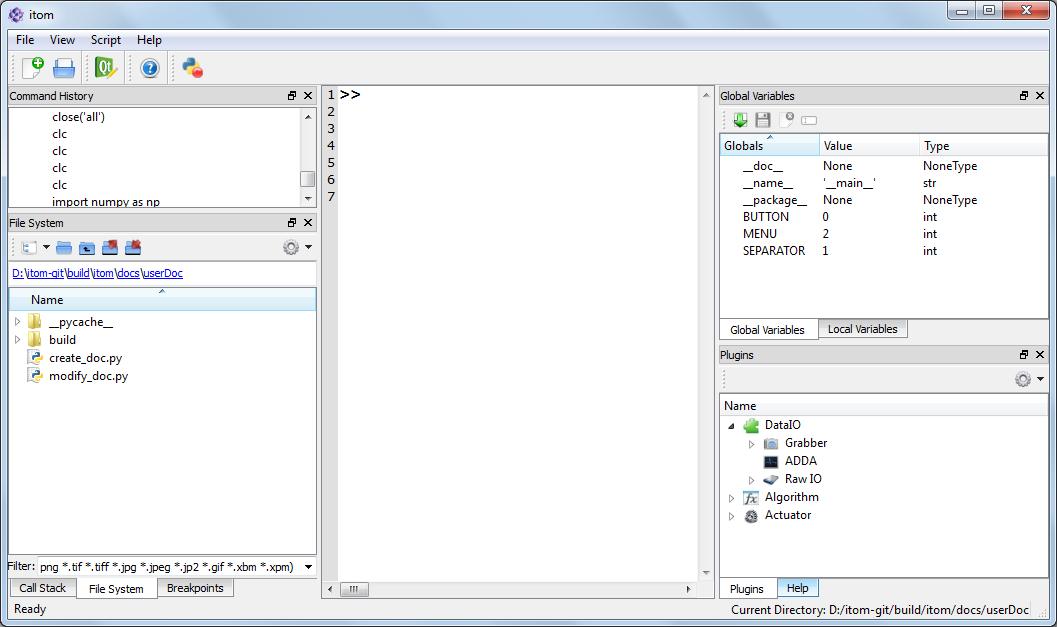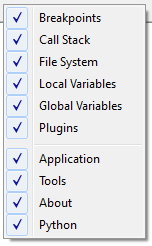5.1. Main Window#
During the startup of itom a splash screen shows the current state of the load process. After having finished, the itom main window appears like in the following screenshot:

The appearance of the application after its start may vary with respect to the depicted screenshot, since the current position, size and visibility of many toolboxes and other components of the overall graphical user interface as stored in the settings at shutdown. They are reloaded at the next startup.
In general, the GUI consists of a command line widget (console) in the center and several toolboxes that can be arbitrarily positioned as well as moved out of the main window itself (floated state). The toolboxes provide access to many main functionalities of itom. Additionally, every opened hardware plugin may provide its own toolbox, that can also be docked into itom’s main window.
Further functionalities of itom are reached by the menu or the toolbars. It is possible to add further user defined menus and toolbars using the python scripting language (see Customize the menu bar and toolbars of itom).
To support high dpi screens, itom enables Qt automatic scaling.
See also
https://doc.qt.io/qt-5/highdpi.html
https://www.qt.io/blog/2016/01/26/high-dpi-support-in-qt-5-6
5.1.1. Command Line#
The command line in the center of the main window allows executing single or multi-line python commands. Additionally all messages, warnings and errors coming from python method calls or itom itself are printed in the command line widget. Errors are highlighted with a red background:

Usually, the last line of the command line shows the “>>” sign, that indicates that the console is ready for a new input. You can either write a single python command and press the return key in order to execute it or you can write multiline commands. In order to create a new line for this, press the Shift + Return (smooth line break). After the final command simply press the return key such that the whole command block is executed.

The current line or code-block that is executed is highlighted with a yellow background. For multi-line commands, itom parses the whole command block and divides it into logical blocks, such that the highlighted background switches from one block to the other one.
In the command line you can use every python command. For inputs you can either use the input() method or
consider using the input dialog mechanism of itom (see Show messages, input boxes and default dialogs). Additionally you can use one of
the following keywords in order to clear the command line:
clc
clear
To clear the command line from an ordinary script, use the command itom.clc().
Instead of typing all commands in the console, write your entire python scripts in the Script Editor.
Usually, the command line automatically scrolls to the last line. However, if you use the mouse wheel during a script execution in order to navigate to a certain line in the command line, the auto-scroll option will be disabled until the command line is cleared again.
5.1.3. Toolboxes#
Content:
The core application of itom already comes with a set of different toolboxes. Additionally, many plugins provide the possibility to open a toolbox for every opened hardware instance, like actuators or cameras. These toolboxes are then also inserted into the main window of itom. Usually toolboxes can be docked into the main window or be in a floating state, such they appear like an unresizable window. If docked, they can be positioned at the left or right side or the top or bottom of the main window. Some of them however are limited with respect to the dockable positions.
All available toolboxes are listed in the menu View >> Toolboxes, where hidden toolboxes can be shown again. Additionally, a right click to any place in the toolbar opens the following context menu where the first items also access the loaded toolboxes. The items after the separator correspond to the toolbars, such that they can be hidden or shown:

The following main toolbars are available:
Global and Local Workspace shows the global and local workspaces of Python.
Plugins shows all loaded plugins including opened instances.
File System gives you access to the file system of your harddrive.
Breakpoints shows all breakpoints added to Python scripts.
Call Stack shows the callstack when the Python script execution stops at a breakpoint.
Bookmarks shows all bookmarks added to any Python scripts.

 Ctrl+N
Ctrl+N Ctrl+O
Ctrl+O
 F1
F1